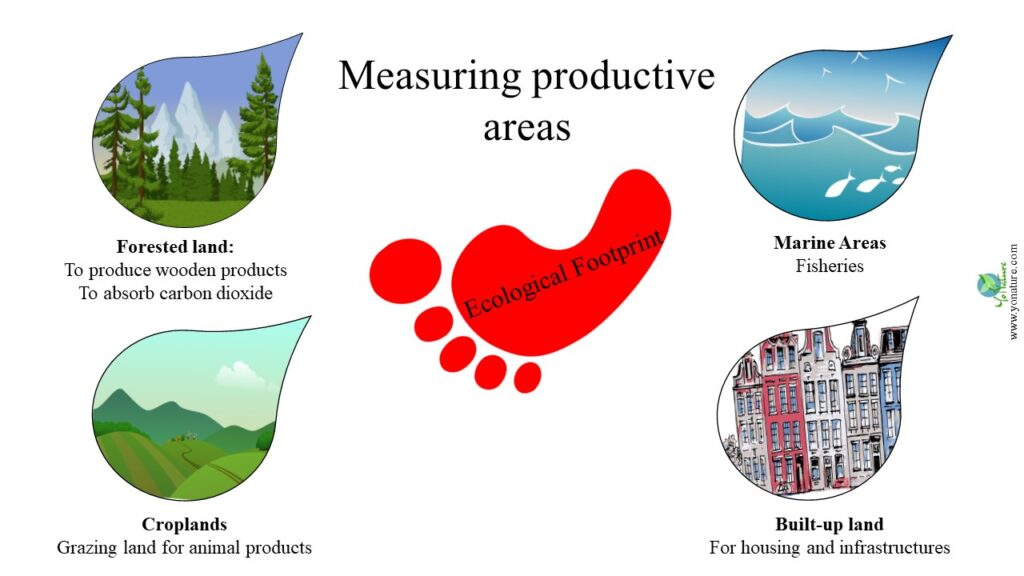The concept of Ecological Footprint explained

Ecological footprint (EF) is a measure of the demands that an individual or a group of persons make on global natural resources. In 1996, Wackernagel and Rees came up with the concept in a book called Our Ecological Footprint.
It basically provides an overview of the complex concepts of the resources needed to sustain human lives. These relate to the rate of resource replenishment, carrying capacity of the Earth and waste disposal.
Since then, the concept became popular around the world. Now it is a common tool to measure the sustainability or unsustainability of common activities.
Highlights of the ecological footprint
Basically, ecological footprint measures what we demand from the Earth compared to what it can produce. The unit we use is gha – global hectares (1 ha = 2.47 acres).
We can use the EF to measure individual, national, regional and global footprints. We can then compare these values to the average bio-capacity of the Earth to know if current practices are sustainable or not.
Measuring productive areas
Additionally, the ecological footprint also measures the amount of productive land we require to produce renewable resources and to absorb the wastes we produce. We evaluate productive areas in terms of:
- Croplands – grazing land for animal products,
- Forested area – for the production of wooden products,
- Marine areas – fisheries,
- Built-up land – for housing and infrastructure and
- Forested land – to absorb carbon dioxide
The EF value thus shows whether an individual or business or government is living sustainably with regards to the carrying capacity of their territory or not. Thus, if they are drawing from the capital of other nations, they become ecological debtors.

Examples of ecological footprint values around the world
EF values vary widely around the world. The larger the value, the less sustainable are the activities.
For instance, based on 2014 data, Qatar topped the list with an EF value of 15.5 gha/person compared to Haiti at 0.7 gha/person. The values reflect different lifestyles with overconsumption on the one hand and poverty on the other hand.
EF value of Qatar v/s Haiti
As it is, people in Qatar enjoy an extravagant lifestyle and use a lot of energy for pumping water. In this way, they have a far greater impact on the Earth’s resources compared to people in poor regions who do not even have access to food and water.
EF values for groups and countries also indicate what is going on and where unsustainable practices are occurring.
In Mauritius, for example, [1] the EF value was 4.5 gha/person in 2010. Although it’s a tiny island, the value is enormous and we attribute it mainly to mass tourism and touristic activities.
Ecological deficit
Globally, there has been an increase in resource demand since the 1970s. We have been using more than the Earth can produce and absorb. And this is mainly due to our activities like industrialization, urbanization and overexploitation of resources.
Because of this, we are now in an ecological deficit, also called an ecological overshoot. It means that the Earth takes more time (instead of one year) to refill and get rid of wastes.
Currently, our demand on Earth equals 1.7 Earths! This means that more than 80% of countries are actually in ecological deficits.
Is the Ecological Footprint a reliable measure?
You can easily calculate your ecological footprint by using calculators like the Global Footprint Network calculator amongst others. Principally, we enter values regarding certain activities into the calculator and then it gives an estimated value.
However, there are certain points in the concept that many people do not agree with. It includes:
- The calculator is just an estimate. It is based on what we feed into it, which again are just estimates.
- We assume that we use the same type of technology in all places. For example, the way we dispose of waste in rich and poor countries is the same.
- Certain activities may put more stress on the environment, like intensive agricultural practices. Eventually, it can lead to land degradation.
- It takes into consideration only what humans need not other species.
- We also do not consider trading. While it may appear that certain nations are living well within their ecological limits, trading increases their resource demands.
- And we also don’t consider impacts such as toxicity, greenhouse gas emissions and water resources.
Ecological footprints can be good tools
Despite all the critics, ecological footprints are one of the best tools to give an idea of the environmental impacts of our daily activities. We are still refining the method though in 2006, we established proper standards to use it.
In 2008, a review by the European Commission acknowledged the limitations of the model but concluded that when we use it with other environmental indicators, the EF can be a good tool. Many businesses like Walmart and governments like the UAE have now embraced the concept and are using it as a measure to decrease their unsustainable practices.
Reference:
- Kelly, R. (2014). Living Planet Report 2014. Global Footprint Network. [Online]Available at https://www.zujiwangluo.org/in-the-news-2/newsroom/page/2/ [Accessed 04/04/2019]

Pingback: Composting Explained: Conditions, Benefits, Problems - Yo Nature
Pingback: positive impacts of tourism on the environment - Yo Nature
Pingback: 14 simple ways to reduce your ecological footprint - Yo Nature